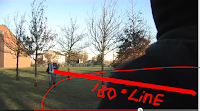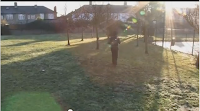Question 6
What have you learnt about technologies from the process of constructing this product?
The technology I used was-
-Canon XHAI camera
-Tripod
-Adobe premiere
-Paint.net
The only time that I had used a camera like this before was when during the prelim task. We needed the tripod and tracks to keep the camera steady and the editing software to edit our film afterwards. As we had done the prelim task, we had used some of this equipment before, but now we were able to properly harness it. I learnt much more about camera movement and positioning the camera to get the best framing. I also learnt about using a tripod effectively in a smaller space, and adapting the tripod to more cramped conditions. One example of this is when we were in the changing rooms and we had to make the tripod as small as possible to balance it on one of the benches, while one of us had to stand behind it and handle and operate the camera.
While filming, we had to take account of the framing and filming techniques we learnt about in class. The technique we tried to incorporate the most was rule of thirds. The rule of thirds is a framing technique that splits up the screen in thirds and arranges the objects on the screen into those thirds. It’s to arrange objects in an order that’s natural and appealing to the eye and this makes a film aesthetically pleasing for the audience. When filming, we used it on several shots, such as the shot where the man looks at his phone, where we tried to film the shot from over the shoulder and place the prop of the phone is the far right third, so the audience’s attention would fall on it. Throughout we tried to frame out shots well, as good framing would make the storyline flow better and help keep the audience interested. To check framing on the shots, we watched all our scenes through the LCD viewfinder on the camera, which gave us a better idea of what the film would look like on screen.
The 180 degree rule is a filming technique, but as we didn’t have very many shots where there were two characters in the same shot so we didn’t get to incorporate it into our film very often. The 180 degree rule is a rule for continuity, and it says that a camera cannot pass a straight line in between two characters without visually showing the movement. This line is straight, and this called the 180 degree line. It’s an important rule to follow as otherwise the film would confuse the audience and make the film hard to follow.
 The only time we got a chance to do the 180 degree rule was when we were filming the man coming up to the ninja. There were two shots of these, each and over the shoulder shot- one from the man’s perspective and one from the ninjas. In both of the shots, the ninja is always on the right side of the frame while the man is on the left, keeping a sort of continuity and flow between the two shots. Continuity was a key part to the filming as it helps keep the audience on focus as it makes the film look like one continuous storyline and thus allows the viewer to fully immerse themselves into the film. To make sure we had the best continuity we recorded what was happening on continuity sheets which made sure we filmed everything correctly.
The only time we got a chance to do the 180 degree rule was when we were filming the man coming up to the ninja. There were two shots of these, each and over the shoulder shot- one from the man’s perspective and one from the ninjas. In both of the shots, the ninja is always on the right side of the frame while the man is on the left, keeping a sort of continuity and flow between the two shots. Continuity was a key part to the filming as it helps keep the audience on focus as it makes the film look like one continuous storyline and thus allows the viewer to fully immerse themselves into the film. To make sure we had the best continuity we recorded what was happening on continuity sheets which made sure we filmed everything correctly. Match on action is another filming technique that involves starting one action on one shot and finishing it in the next. It allows the audience to look into detail at certain actions and makes the film more interesting. The only time we really used match on action was in the series of two over the shoulder shots, where the man is seen running towards the ninja in the first, and then stops in the second. This creates a flow in the two shots and looks much better then two stationary shots of two people just standing staring at each other. Also on these two shots, we were able to use Manual focusing, so that the farther away character was more blurred out then the one who was closer. Action reaction shots are similar, as they also tie a story together and create a sense of flow in the film. We didn't get a loot of chances to do these either, although after the two over the shoulder shots, there is a cut to the shot of the word “challenge” which is a reaction to the previous shots as it shows what will come next from this confrontation.
Safety shots are shots which are taken as extras after a good take is done. The term is also applicable to similar shots taken slightly differently, to experiment with the storytelling of a scene. These provide a sort of padding so that when it comes to editing the filmmaker has lots of choices and can get the best result for their film. Total shots are shots of the entire scene taken from afar, and are used as a fall back in case all the safety shots are not workable. If the safety shots don’t work out, then it means that the filmmaker can go back to the total shot and take parts of it to use in the final product. While filming, my group made sure to take safety shots of many of the shots with movement, such as the tracking shot which had over eight takes. However we found that we should have also taken more safety shots of more static scenes as some of these made our film ineffective in some areas. We also weren't able to make many total shots at the area we were filming in was full of obstructions and most of our shots didn't include much action.
While filming we learnt that weather could change everything in filming. There were times whilst filming that the weather was very dark and other times when it was perfect for filming. One of our shots included a time lapse of the sky and we set up the camera to take a long shot of the sky. However it was very cloudy and we feared that the shot wouldn't show enough variation. However when it came to editing, we realised that this was perfect when speeded up.
 There was also times where the weather allowed us to get brilliant shots, such as in the shot from behind the ninja when he walks off into the distance. In this shot, we were able to capture a lens flare as the sun was out and at a perfect angle. Location can also heavily influenced how one films. We realized we had to position our camera on uneven ground which meant we had to maintain spirit level at all times and make sure the tripod was balanced. If it wasn't our shots would be uneven and tilted.
There was also times where the weather allowed us to get brilliant shots, such as in the shot from behind the ninja when he walks off into the distance. In this shot, we were able to capture a lens flare as the sun was out and at a perfect angle. Location can also heavily influenced how one films. We realized we had to position our camera on uneven ground which meant we had to maintain spirit level at all times and make sure the tripod was balanced. If it wasn't our shots would be uneven and tilted.With the editing software, Adobe Premier, we learnt many new things about using it. First, I learnt here are more then one way of cutting a rush- one can splice it with the razor tool or slowly cut it down by dragging it to the frame you want it to stop at. Previously I had only been splicing but I learnt that splicing is best for cutting the rush while dragging is better for fine tuning a shot.
 |
| An example of a bin, taken from google images |
I also learnt the value of having a bin to keep all the rushes of film and sound, as it means that there's always a raw of the media to use if you even make a mistake. It also keeps everything together, so you can see that the different things you've been using. We learnt a lot about effects and using the timeline with video and audio layers, which allowed us to easily edit through our work and organize the film. We also learnt techniques of fading opacity of titles to make them fade into the film and lowering the volume of sound so different sound clips faded together.
While filming we make a lot of mistakes, but were able to rectify them. When filming there was the tracking shot. This was the first time using tracks and thus it meant we weren't at all good at using them. To fix this we took many takes of this shot, and in different ways(such as holding the camera still, physically carrying the camera behind him etc). This gave us a good range of shots to use and we ended up with a good shot. There was also the shot of the mask/sword and calendar hanging in the changing room. It was very difficult to position the camera here, and we ended up having many takes of that shot as well, and taking it both on the tripod and off. Finally, the filming of the final shot was very difficult as we first intended on a low angled shot, but this was impossible to do with our equipment. Instead, we took a slow shot that panned up while zooming out, and rested on a midshot of the ninja child, which was quite effective and more interesting then our original idea. While editing, our program crashed multiple times. To help ourselves, we made sure we saved frequently so we didn't loose any work. The time lapse was also a problem as we found the entire shot was too long and we couldn't speed it up more then 10000% of it's original play speed. To make that shot smaller, we ended up cutting a section of it, and it still was ok after, so the problem was fixed.


No comments:
Post a Comment